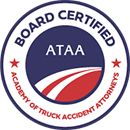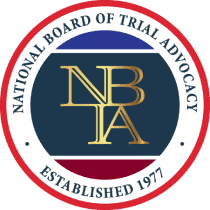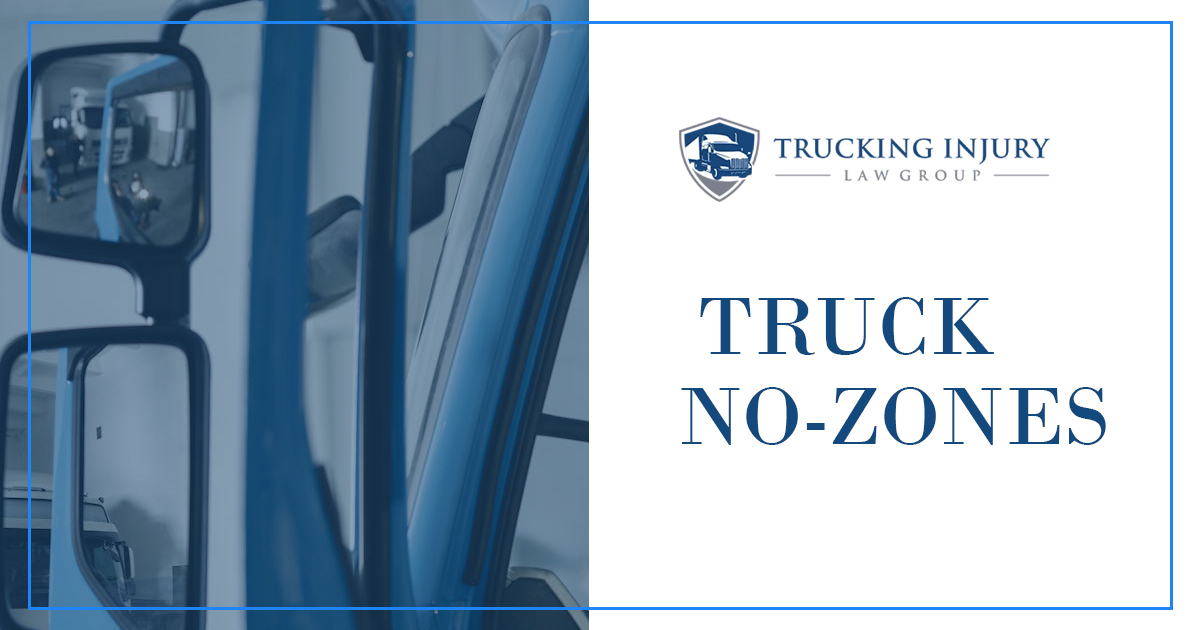Truck Blind Spots: How To Stay Out of the No-Zones
Large trucks and buses are a major part of our transportation system. However, these massive vehicles come with risks to other drivers. Trucks, buses, and other commercial vehicles have large blind spots, commonly known as “no-zones”. It is difficult for truck drivers to see other vehicles around them in those spots. All drivers need to learn about these blind spots and how to navigate them safely.
Driving in truck blind spots can be extremely risky. Traveling in these spots increases the chances of accidents and collisions. When a vehicle is in a truck’s blind spot, the driver may not be able to see it, leading to dangerous situations.
At the Trucking Injury Law Group, we know that these no-zones can lead to disastrous results. For that reason, we want you to be aware of the potential risks associated with driving in these no-zones.
Let’s look at how to ensure your safety and the safety of others around you while sharing the road with large trucks and buses.
What Are No-Zones?
A “no-zone” is a specific area around a large commercial vehicle, like a bus or truck. When the driver is at the wheel, their visibility is limited. These blind spots are usually located on the sides of the vehicle, along with the rear and front of the truck.
When vehicles try to merge or pass in these zones, the potential for an accident dramatically increases. Knowing where the no-zones are located lets you stay out of these spots and gives the driver plenty of room to maneuver.
Let’s look at where the no-zones are located near commercial motor vehicles.
Front No-Zone
As you may imagine, this blind spot is located in front of a truck, and it is one of the most dangerous spots near a vehicle. According to the National Highway Traffic Safety Administration, almost 29% of all accidents are rear-end collisions. Any accident in these spaces can be disastrous. The front no-zone is the space directly in front of a truck or bus that extends several car lengths ahead of the vehicle’s bumper. The driver sits up high in the tractor unit, making it difficult to see small cars or other vehicles passing directly in front of them.
Unfortunately, if the truck needs to make a sudden stop, and you’re in the front no-zone, it could mean a deadly rear-end collision. These vehicles require more time to stop due to the heavy weight of the cargo. Following too closely in front of a truck or not giving them enough room to pass can jeopardize the safety of everyone on the road.
Side No-Zones
Another dangerous spot near a truck is on the sides. These no-zones run along the entire length of the vehicle. While the left side does have limited visibility, the right is hazardous. Anyone passing the truck or lingering in these areas is at a higher risk of an accident. These side no-zones extend all the way from the truck’s cab to the rear wheels. If the driver cannot see your vehicle in their side view mirrors, you are driving in this hazardous no-zone.
There are many possible accident scenarios that could happen in these posts. If the truck changes lanes while you’re in the side no-zone, you could be sideswiped or pushed off the road. Also, if you try to pass suddenly and the truck accelerates without knowing you’re there, that can lead to a rear-end collision.
Rear No-Zone
This term describes the blind spot area located directly behind a large truck or bus. Once again, the truck driver might not be able to see any smaller vehicles passing behind due to their reduced visibility. These no-zones can extend up to 30 feet behind the truck, depending on the size and length of the vehicle. In this area, you are almost invisible to the driver.
Trucks are larger and heavier than other vehicles on the road. If they stop suddenly, and you’re behind them, it can increase your risk of underride. With that, your vehicle could slide under the truck. These accidents often result in fatalities. Along with that, the truck can kick up debris, which can strike your vehicle.
Now that you know all the no-zones and blind spots around a truck, there are a few ways to share the road safely with these large vehicles.
Safety Tips for Driving Near Trucks
As with any vehicle on the road, you need to be aware of everyone around you, especially those large trucks, buses, and other commercial vehicles.
If you decide to pass a truck, always check your mirror and make sure that you can see the driver. One way to check the truck driver’s visibility is if you cannot see them in their side mirrors, then you are practically invisible to the driver.
When you need to pass, always signal and accelerate to pass in a prompt manner. By doing this, you can make sure you get out of those no-zones as safely and quickly as possible. Along with that, never linger in these blind spots. Staying in a no-zone is dangerous, increasing your chances of an accident. Once again, you never want to pass on the right side. These vehicles have large blind spots on their side, which could put you in danger by trying to merge or pass in this spot.
Trucks and buses require additional space for wide turns, so you need to be aware of this when driving near them. If a truck or bus has its turn signal on, never try to squeeze by it or get between the vehicle and the curb. Doing so could put you in danger and cause an accident. Also, never “block the box” or stop in front of the line when stopping at an intersection. Buses and trucks need that space to complete turns safely.
If you want more resources to share the road with large trucks, the Federal Motor Carrier Safety Administration provides a few safety tips:
Safety should always be the top priority when driving around large trucks and buses. Being aware of the no-zones and taking the necessary precautions to stay out of them can help prevent accidents and keep everyone on the road safe.
And if you have ever been injured or lost a loved one due to a trucking accident, Trucking Injury Law Group lawyers are here to help. We offer our services throughout the United States. If you would like to learn more about us or want to discuss your case, make sure to schedule a free initial consultation.






